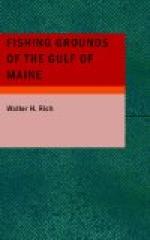Little La Have and the La Have Ridges are simply continuations of this back toward the Western Bank for a distance of about 45 miles. This places the eastern limit in about 62 deg. 50’ west longitude, the northern and southern boundaries being about as those of La Have Bank. The area of the ridges is about 1,575 miles. The bottom here is a succession of ridges of pebbles and gravel with occasional patches of rocks. Depths are from 53 to 80 fathoms. The current, occasionally strong, is weaker here than farther W. on the bank and, except during easterly winds, is but little noticed. The general set is westerly.
“The Ridges” says the report before mentioned, “were for a number of years one of the favorite resorts for halibut catchers in winter, and many good catches of cod were taken here at that season. At present but few halibut are caught except in the deep water along the southern edge of the ground, where they sometimes have been found quite plentiful during nearly the entire year.” Apparently there has not been much change in these conditions since the writer’s time; fish seem to be present here In about the same quantities as in former years.
One piece of bottom, having depths of 25 to 50 fathoms over red clay, lying approximately in 43 deg. 08’ to 43 deg. 10’ north latitude and about 81 deg. to 83 deg. west longitude, seems a good spring and early summer ground. Apparently red-clay bottom indicates a good halibut ground, as this species is usually present where such a bottom is found.
Hake are found in good numbers in the deep water about the edges of the ground and even on the Ridges.
These waters are quite heavily fished from Canadian ports, and a fair number of American vessels visit them each year, most of them hailing from Boston or Gloucester.
Scandinavian Bank. Eighteen miles SSW. from Shelbourne Light. Nova Scotia. It is about 3 miles long in an E. and W. direction by about 1/2 mile wide. In general, the bottom is level, with depths from 50 to 70 fathoms; the shoal parts are sharp and rocky, the bottom over the deeper portions being composed mostly of small black and yellow pebbles.
This is a summer halibut ground (July and August) in depths from 45 to 60 fathoms, and halibut occur in October in the deeper waters about it. It is also a fair summer cod ground, and cusk are present in the deep water about the edges during most of the year. In general, species and seasons are much as on Roseway.
Western Bank. This is one of the most important fishing grounds of the western Atlantic, whether as regards size or the abundance of its product. It lies S. of Cape Breton Island and the eastern part of Nova Scotia between the parallels of 42 deg. 55’ and 44 deg. 46’ north latitude and the meridians of 59 deg.04’ and 62 deg. 35’ west longitude. It has a length of 156 miles and a width, including the Middle Ground, of 76 miles. It is about 420 miles E. 1/2 S. from Boston to the southwestern edge, which means about 48 hours’ steaming for the otter-trawl fleet.




